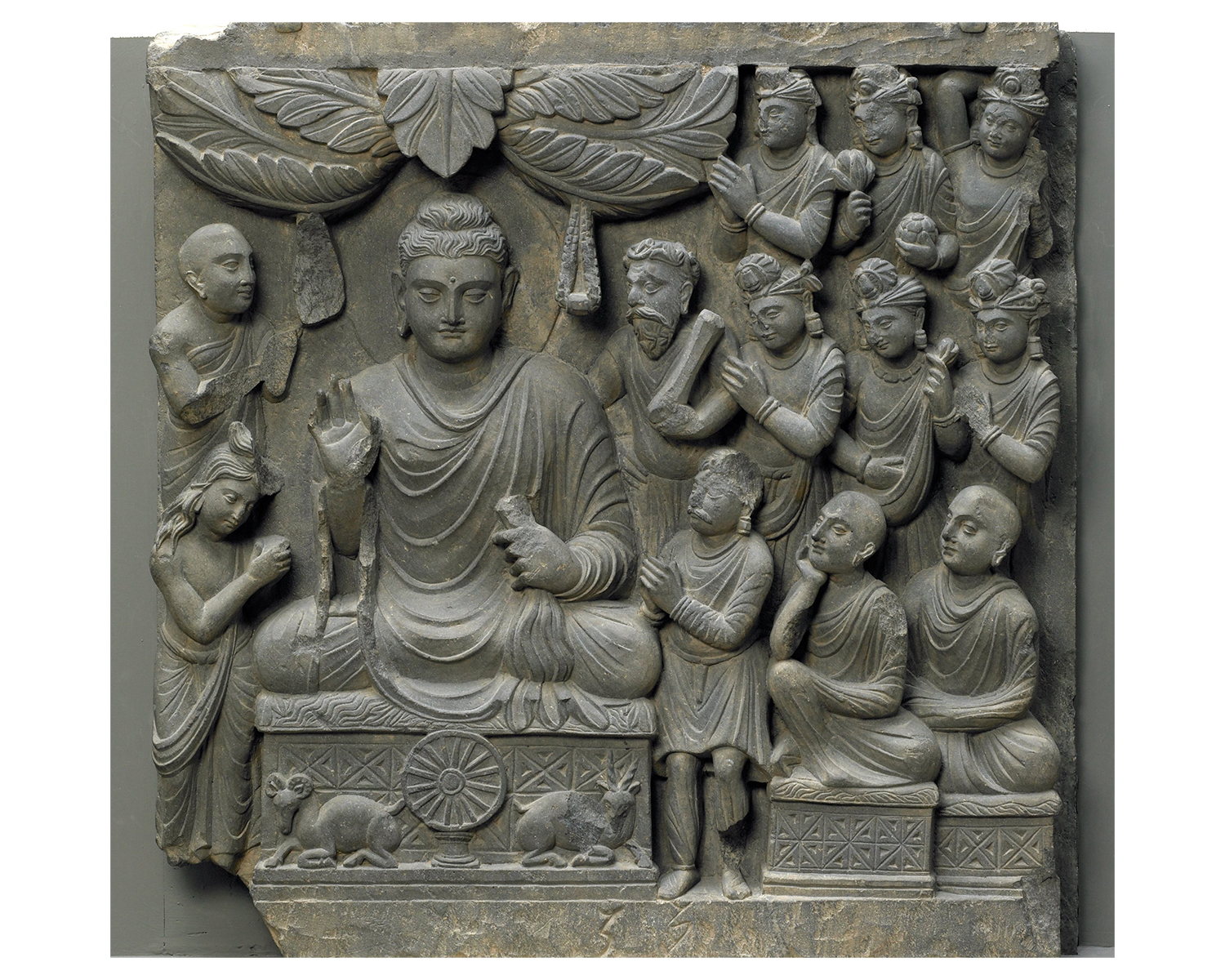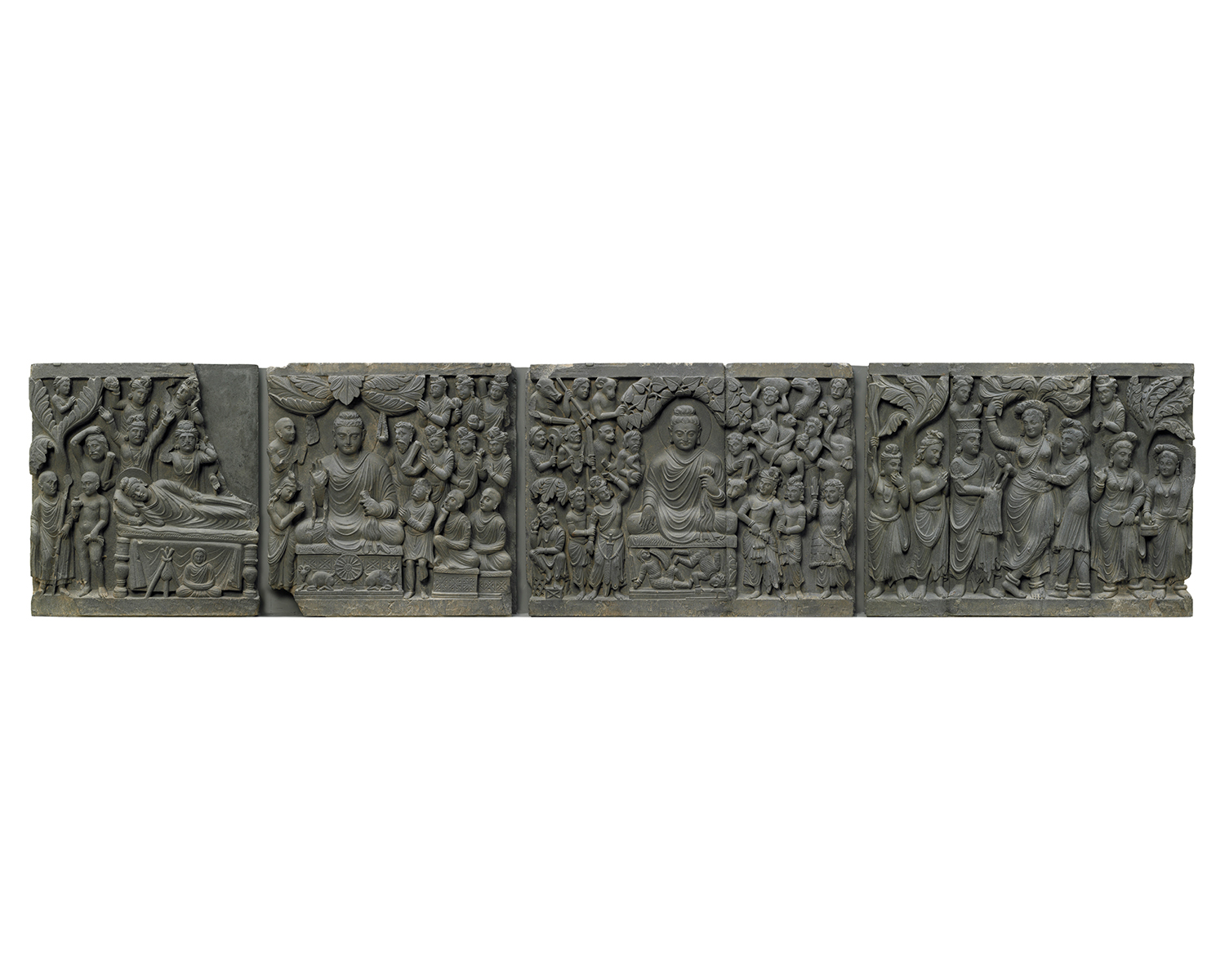ARTICLE
Four Scenes from the Life of the Buddha, Gandhara
Carved out of grey schist between the late second and early third century CE in Kushan Gandhara in north-western South Asia, the relief panels show four landmark scenes from the life of the Buddha. Originally part of a large stupa, they probably adorned the medhi or the harmika, an enclosure at the apex of the central mound. They were arranged sequentially in a manner that narrated the main events from the life of the Buddha to devotees as they performed ritual circumambulations around the stupa. The panels are now housed in the collection of the Freer Gallery of Art in Washington DC, USA.
The first panel depicts the events that surround the Buddha’s miraculous birth. In the scene, a larger-than-life figure of Queen Maya holds on to the branch of a tree in a grove near Lumbini, Nepal. The Buddha emerges as a young child from her right side, recognisable by the small ushnisha on his head. He is symbolically received by the South Asian god Indra, who wears a crown and is distinguished by his third eye. They are flanked by attendants on both sides. The second panel depicts the moment of the Buddha’s enlightenment as he sits under the Bodhi tree, touching the ground with his right hand in the bhumisparsha mudra. In an important episode in the Buddhist canon, in the moments before his enlightenment Siddhartha Gautama is confronted by the demon king Mara, who presents various temptations and brings forth his armies in an effort to claim the throne of enlightenment for himself. Invoking the earth goddess as witness to his ascendancy by using the bhumisparsha mudra, Siddhartha emerges victorious — two of Mara’s demonic manifestations are shown vanquished at the Buddha’s feet. The gesture embodies unshakability and the triumph of spirit over matter. This episode, when Siddhartha Gautama becomes the Shakyamuni Buddha, also signifies the moral triumph of good over evil. The third panel shows the Buddha delivering his first sermon in the Deer Park at Sarnath. The wheel on his seat symbolises the wheel of dhamma or law. He is surrounded by twelve figures representing his disciples and devotees, all of whom face him and listen with rapt attention, some with hands folded in obeisance. This moment — when he offers his teachings to his disciples, the monks and nuns who will spread his message widely — is called the dharmachakrapravartana, the setting in motion of the wheel of dhamma, to be diffused everywhere. The fourth and last panel represents the parinirvana or death of the Buddha. He lies peacefully on his side with his head on a cushion as his disciples in the upper register of the panel show marked signs and gestures of grief. In contrast, Subhadra, the Buddha’s last convert, seated in the lower right register with his back towards the Buddha, shows no sign of distress. He seems to have understood that the moment signifies the Buddha’s attainment of nirvana.
The iconographic style and subject matter of the relief panel reflect a medley of artistic and cultural traditions. This can be attributed to the syncretic culture of Gandhara during the Kushan reign, coupled with its geographical location at the meeting point between western India, present-day eastern Pakistan, Central Asia and the Mediterranean. The Kushans absorbed influences from the Hellenised cultures of the Central and West Asian regions as well as those of South Asia through Gandhara’s cosmopolitan population that included Greeks, Scythians, Parthians, Buddhists, Hindus and Central Asian nomads. Thus, Queen Maya in the first scene dons a Greek chiton, hairstyle and wreath but holds on to a tree with her legs crossed in the typical pose of the shalabhanjika yakshi — a deity symbolising fertility, who belonged to local pre-Buddhist cults of the subcontinent, and was later absorbed into the Buddhist tradition. Peepal leaves and descending palms appear side-by-side and figures like the Buddha and Indra are dressed in heavily pleated Hellenistic robes tied in a distinctly Indian fashion. These panels thus form an example of the unique idiom developed by Gandharan artists, borrowing elements from the diverse cultures of the locals, migrants and travellers in the region, and incorporating it within the vocabulary of the Buddhist tradition that was beginning to take root here.
The narrative panels at Gandhara seem to have been produced around the same time that the early precedent of the round stupa was being substituted by the typically Gandharan specimen with a square plinth and a taller, more pillared structure, in the first and second centuries CE. Moreover, the events depicted in these works are culled from canonical texts instead of oral narratives, and represented as key biographical episodes rendered in discrete, chronologically arranged panels. These were arranged in a linear sequence in order to narrate a unitary story as devotees circumambulated the drum of the stupa. This represents the Gandhara style’s important divergence from previous Indic iconographic traditions, in which aspects and events relating to spiritual figures are represented as synchronous, with chronological time as irrelevant.
In contemporaneous works from Gandhara, narrative relief panels often contain carvings of curtains, Dionysian elements and Corinthian columns that act as scene separators. As Gandhara offered a meeting point for Greek, Sanskrit and Buddhist cultures, scholars have recently suggested that the narrative mode that developed in Gandharan sculptural panels might have had some association with the dramatic traditions converging in the region. The presence of Dionysian traditions in the region has already been noted; Ashvagosha, one of the earliest Buddhist playwrights, was also present in Gandhara during this time period. Moreover, a Greek theatre has been found at Ai Khanoum, a site located to the east of Gandhara. Such evidence, alongside other visual devices found in the carvings, such as onlookers or viewers on balconies or on the edges of the scene, suggests a distinct influence of drama on the Buddhist art that developed in Gandhara.
Most importantly, the contents of the narrative panels were key events from the life of Buddha, suffused with symbolic meanings that were clear even to lay worshippers. The carvings thus served to reflect and reinforce the divinity of the Buddha, among other such expressions in the plastic arts of Gandhara between the first century BCE and the seventh century CE.
Bibliography
Asia Society. “Narratives and Architectural Context.” Gandhara Exhibit. Accessed January 9, 2023. https://sites.asiasociety.org/gandhara/exhibit-sections/narratives-and-architectural-context/.
Behrendt, Kurt A. The Art of Gandhara in the Metropolitan Museum of Art. New York: Metropolitan Museum of Art, 2007.
Brancaccio, Pia, and Xinru Liu. “Dionysus and drama in the Buddhist art of Gandhara.” Journal of Global History 4, no. 2 (July 2009): 219–44. https://doi.org/10.1017/S1740022809003131.
Dehejia, Vidya. “On Modes of Visual Narration in Early Buddhist Art.” The Art Bulletin 72, no. 3 (1990): 374–92. https://doi.org/10.2307/3045747.
Taddei, Maurizio. “Narrative Art Between India and the Hellenistic World.” Accessed January 10, 2023. https://heiup.uni-heidelberg.de/journals/index.php/transcultural/article/view/22215/15978.











